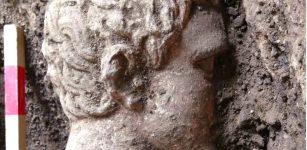Saint George: Knight Warrior Who Refused To Denounce His Faith And Died A Martyrs Death
A. Sutherland - AncientPages.com - Although the historical authenticity of St. George’s existence has long been a subject of controversy, he remains an important figure in the history of faith, in history in general, and above all - in legends.
Saint George was born in the third century in Cappadocia, Turkey, died on April 23, about 303 in Lydda (now Lod in Israel).
 Saint George's monument in Tbilisi, Georgia. Image credit: Haakon S. Krohn - CC BY-SA 3.0
Saint George's monument in Tbilisi, Georgia. Image credit: Haakon S. Krohn - CC BY-SA 3.0
Sources vary regarding his birthplace; two popular versions mention Coventry (in England) and Cappadocia in Turkey, where his father came from. According to the oldest preserved version of the legend, dating from the 10th century, George was born in a noble family: one of his grandparents was the governor of Cappadocia, and the other was the duke of Lydda. As a widow, his mother returned with George to her city and provided him with education.
Already at a young age, he followed his father's example, exhibiting military talents. Immediately after reaching the age of 18, George volunteered to join the Roman legions and soon came to the rank of a senior officer in the Roman army, commanding five thousand soldiers.
A Knight On A White Horse
The traditional depictions of George are based on his most famous deed - the killing of the dragon.
He is shown as a knight riding a white horse and dressed in a short tunic, often bearing a lance tipped by a cross and killing a dragon.
His other attributes included a horse, an angel with a laurel wreath or with a crown, a lamb, a white banner or a lance with a red cross, the Martyr's Palm.
There were many places dedicated to his worship; he patronized religious orders, cities and entire countries.
Persecution Of Christians
In 303, Roman Emperor Diocletian (244-311 AD) issued an edict allowing the persecution of Christians within the empire. The so-called Diocletianic Persecution (303–312), - the empire's last, largest, and bloodiest official harassment of Christianity - eventually, failed to eliminate Christianity in the empire.
Although he was a Christian himself, George was forced to participate in persecutions, but he refused to sacrifice to Roman deities. He distributed all his possessions to the poor, openly criticized the edict of Diocletian, and tore off the anti-Christian edict from the walls of Nicomedia. For these actions, he was punished severely. He was subjected to extremely cruel and long agonies.
He was nailed to the cross, tortured on the wheel, and finally beheaded under the city walls of Nicomedia (now Izmit, in Turkey) on 23 April 303.
Alexandra of Rome, the reputed wife of Emperor Diocletian who also secretly converted to Christianity, joined George in martyrdom as well. George's body was transported to Lydda (under Byzantine times called Diospolis, now Lod, Israel), where he was buried.
St. George And The Dragon
The history of St. George was described, among others by an Italian chronicler and archbishop of Genoa, Jakub de Voragine around 1260, in the "Golden Legend" (also known as Legenda Aurea).
 Miniature from a 13th-century Passio Sancti Georgii (Verona) source: Public Domain
Miniature from a 13th-century Passio Sancti Georgii (Verona) source: Public Domain
The versions of the legend vary a lot. One says that at the water source that supplied the city of Silene (probably later Cyrena in Libya), a horrible dragon made its nest. Trying to keep it away from the town, the citizens drew lots to decide whom among the youngest in town to sacrifice to the monster. One day, the daughter of the king had to be the dragon’s next offer.
The monarch begged for her life, but his attempts were in vain. Just before she was sacrificed to the dragon, St. George appears riding his horse and he manages to neutralize the dragon (this scene was many times immortalized by artists).
St. George – Patron Of Many Regions, Cities And Countries
Saint George is the patron of many countries, including England, Georgia, Portugal, the Netherlands, Germany, Sweden, Lithuania, Russia, Bosnia, Serbia, Montenegro, and Ethiopia, patron of Palestinian Christians.
He is also a patron of many cities and regions and many brotherhoods, religious congregations, and orders of knights were founded under the invocation of St. George, including the Order of Saint George from Carinthia, Order of Saint George from Alfama. Saint George is also a patron of knights, wanderers, miners, soldiers, blacksmiths, coopers, artists, prisoners, and scouts.
As a national saint in England, he continued even after his death to give hope and comfort to people in need.
The image of Saint George, a knight on a horse, killing a dragon, is known to almost every European. No doubt, this legendary figure is one of the most important symbols of the Christian world.
His memorial day is celebrated in most countries on April 23.
Written by – A. Sutherland - AncientPages.com Senior Staff Writer
Copyright © AncientPages.com All rights reserved. This material may not be published, broadcast, rewritten or redistributed in whole or part without the express written permission of AncientPages.com
More From Ancient Pages
-
 The Bushido Code: Centuries-Old Unwritten Code For Ideal Samurai Warrior
Featured Stories | Dec 26, 2016
The Bushido Code: Centuries-Old Unwritten Code For Ideal Samurai Warrior
Featured Stories | Dec 26, 2016 -
 Unique Viking Age Hearths Discovered In Tallinn, Estonia
Archaeology | May 11, 2022
Unique Viking Age Hearths Discovered In Tallinn, Estonia
Archaeology | May 11, 2022 -
 Mysterious Valkyrie Eir Remains An Enigma In Norse Mythology
Featured Stories | Apr 4, 2018
Mysterious Valkyrie Eir Remains An Enigma In Norse Mythology
Featured Stories | Apr 4, 2018 -
 10 Remarkable Jain Temples – Marvelous Ancient Architecture And Stone Carvings
Featured Stories | Dec 17, 2015
10 Remarkable Jain Temples – Marvelous Ancient Architecture And Stone Carvings
Featured Stories | Dec 17, 2015 -
 Is A Viking Settlement And An Even Older Church Hidden Under St. Clement’s Church In Norway?
Archaeology | Apr 13, 2017
Is A Viking Settlement And An Even Older Church Hidden Under St. Clement’s Church In Norway?
Archaeology | Apr 13, 2017 -
 Ancient DNA Shows Neanderthals Used Plant-Based Medicine To Treat Pain And Illness
Archaeology | Mar 9, 2017
Ancient DNA Shows Neanderthals Used Plant-Based Medicine To Treat Pain And Illness
Archaeology | Mar 9, 2017 -
 Napoleonic Code: Why Was One Of The Most Influential Civil Codes Flawed?
Ancient History Facts | May 16, 2020
Napoleonic Code: Why Was One Of The Most Influential Civil Codes Flawed?
Ancient History Facts | May 16, 2020 -
 Ancient Egyptians Invented World’s Oldest Egg Ovens And They Are Still In Use
Ancient History Facts | Jul 6, 2021
Ancient Egyptians Invented World’s Oldest Egg Ovens And They Are Still In Use
Ancient History Facts | Jul 6, 2021 -
 Incredibly Well-Preserved 2,000-Year-Old Statue Of Greek God Hermes Found In Heraclea Sintica, Bulgaria
Archaeology | Jul 12, 2024
Incredibly Well-Preserved 2,000-Year-Old Statue Of Greek God Hermes Found In Heraclea Sintica, Bulgaria
Archaeology | Jul 12, 2024 -
 On This Day In History: Seismologist Charles Richter Was Born – On Apr 26, 1900
News | Apr 26, 2016
On This Day In History: Seismologist Charles Richter Was Born – On Apr 26, 1900
News | Apr 26, 2016 -
 Ice Age People Returned To Central Europe Much Earlier Than Previously Thought
Archaeology | Jul 3, 2024
Ice Age People Returned To Central Europe Much Earlier Than Previously Thought
Archaeology | Jul 3, 2024 -
 Ancient Syriac Epitaphs Discovered In Tomb Of Priest Monoha Shed New Light On The Assyrian Empire
Archaeology | Dec 23, 2019
Ancient Syriac Epitaphs Discovered In Tomb Of Priest Monoha Shed New Light On The Assyrian Empire
Archaeology | Dec 23, 2019 -
 Manco Capac: Legendary Founder Of The Inca Dynasty Of Peru
Featured Stories | Jun 19, 2016
Manco Capac: Legendary Founder Of The Inca Dynasty Of Peru
Featured Stories | Jun 19, 2016 -
 LIDAR Technology Reveals Secrets Of Ancient Maya Civilization
Archaeology | Feb 3, 2018
LIDAR Technology Reveals Secrets Of Ancient Maya Civilization
Archaeology | Feb 3, 2018 -
 9,000-Years-Old Underwater Artifacts Found Off The Western Australia Pilbara Coast – Protect Flying Foam Passage Scientists Say
Archaeology | Jun 27, 2023
9,000-Years-Old Underwater Artifacts Found Off The Western Australia Pilbara Coast – Protect Flying Foam Passage Scientists Say
Archaeology | Jun 27, 2023 -
 Understanding The Green Sahara’s Collapse
Earth Changes | Aug 22, 2024
Understanding The Green Sahara’s Collapse
Earth Changes | Aug 22, 2024 -
 On This Day In History: Precious Rosetta Stone Found By Napoleonic Expedition To Egypt – On July 15, 1799
News | Jul 15, 2016
On This Day In History: Precious Rosetta Stone Found By Napoleonic Expedition To Egypt – On July 15, 1799
News | Jul 15, 2016 -
 Intriguing Ptolemaic And Roman Treasures Unearthed In Al Bahnasa, Egypt
Archaeology | Jan 10, 2024
Intriguing Ptolemaic And Roman Treasures Unearthed In Al Bahnasa, Egypt
Archaeology | Jan 10, 2024 -
 10 Viking, Norse And Icelandic Symbols Explained
Vikings | Sep 5, 2023
10 Viking, Norse And Icelandic Symbols Explained
Vikings | Sep 5, 2023 -
 Astronomically Aligned Pyramidal Buildings Of America’s Oldest City Reveal How Its Builders Apprehended Space And Time
Archaeology | Apr 15, 2021
Astronomically Aligned Pyramidal Buildings Of America’s Oldest City Reveal How Its Builders Apprehended Space And Time
Archaeology | Apr 15, 2021
